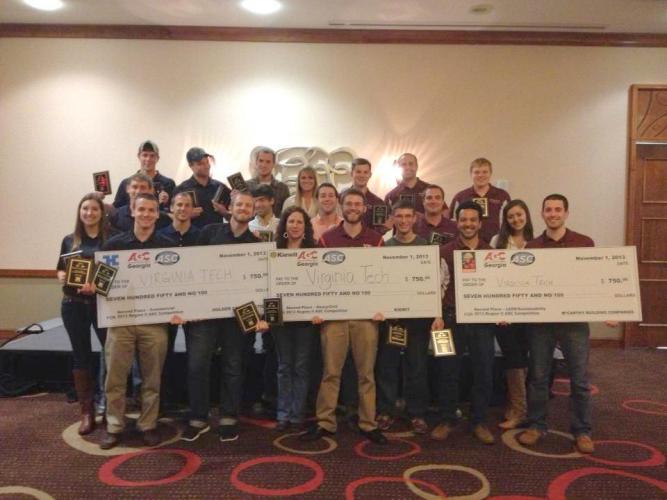Fall 2013 Construction Competition Team
Late in October, twenty-one construction students from both the Building Construction program and the Construction Engineering and Management program made school history as all three teams placed second in the ASC Region 2 competition, held in Peachtree City Georgia. The three teams that participated in the competition included Heavy-Civil team, Commercial team and a LEED and Sustainability team. The Commercial team also received the Award of Distinction for the best pre-qualification package.
The ASC Region 2 consists of 25 different colleges and universities to include such schools as Clemson, Auburn, University of Florida and Georgia Tech to name a few.
The Heavy-Civil team consisted of team captain Sam Houchins, and team members Mike Cross, Brett Dietrich, David Henderson, Travis Nice and Tyler Nice. The team was responsible for assessing risk, developing construction schedules, completing an estimate and evaluating cash flow for a bridge in southern Florida. The problem was extremely challenging as the bridge in the problem was the only access point from the mainland to Key Biscayne and the project had an extremely aggressive schedule and tight site constraints. This problem was sponsored by Kiewit and the competition problem was managed by 2010 CEM graduate Jason Lieb who is a Kiewit employee. Jason was a team member of the first Heavy Civil Team that won the competition in 2008.
The LEED team consisted of team captain, Justin Rajadhyaksha, and team members Jeff Bonica, Ben Carpenter, Andrew McNulty, Rex Holmes and Glenn Sullivan. The team was responsible for analyzing a campus building that was attempting to receive a specific LEED certification as well as meet several regional green requirements. The project was extremely challenging to evaluate as there were many constraints related to the building located on the urban campus of Georgia Tech. The team was responsible for determining what credits the building could achieve and justify those points. This problem was sponsored by McCarthy. Justin Rajadhyaksha, a senior in Building Construction and returning team member described the competition experience in this way,” These ASC Competitions are always very in-depth, demanding, and thought provoking. They provide valuable educational experience to us as students, and are also great preparation for a career in the construction industry. Analyzing real world scenarios in a competition setting like this, and putting ourselves in these stressful, time-crunch situations reminds me that we invent the future. That is why I choose to participate in the LEED Competitions, because we can sustain the Earth through construction, we have the power to build a more sustainable tomorrow.”
The Commercial team consisted of team captain, Andrew Adams and team members, Tyler Edwards, Tim Gross, Sam Houff, Patrick Pennell and Michele Woodford. The team was responsible for creating a construction estimate, a schedule and a model of their processes as well as evaluating ways for the building to achieve LEED certification. The building was located on a college campus and required them to design a geothermal heating system. The team received the Award of Distinction for their efforts in researching the construction of geothermal systems and their overall approach to the problem solution. This problem was sponsored by Holder Construction. Sam Houff a senior in Building Construction described his experience as a commercial team member in this way, "The ASC competition put us in a situation we will find ourselves in at some point during our careers. A complicated problem statement with extremely limited time and high expectations from an owner. We were challenged and succeeded at not just completing the problem, but completed it above the rest of the competition showing how as Virginia Tech we really do invent the future."
Tyler Edwards, a Junior in the Building Construction competed in the competition for the first time and found it to be very rewarding. "The Competition offered experience in solving the real-world challenges of the construction industry through strategic thinking. I also believe that the competitive atmosphere simulated the same excitement and time-contingent decision making that is crucial to the success of a project. It was an invaluable experience,” said Edwards.
In order to help students decide if they would like to compete on a team, the program allows for each team to bring shadows to the competition. These students work with the team during the preliminary preparation for the competition, but are not allowed to complete with the team during the actual competition. There is a separate shadow competition that is also sponsored by Kiewit and was coordinated by Kate Asselin, a 2008 graduate of the Building Construction program. The shadow students from each university are assigned a team to work with when they arrive at the competition. It is very challenging as the students are expected to complete an analysis of the problem and develop a presentation within 4 hours, working with individuals they just met. Catharine Moore, a junior in CEM was a shadow for the Commercial Team. “The competition in Atlanta allowed me to gain real world experience and work on an actual project while in a controlled setting. This was a huge eye opener to me because I haven't had the opportunity to participate in an internship yet. Being a shadow, I was grouped with students from other participating schools. This was a great learning experience in itself because each school has a slightly different approach on teaching students pursuing a degree in the construction field so I was able to broaden my thoughts and ideas of the industry,” said Catharine when describing her experience.
Overall, the teams excelled in this competition and are looking forward to the National Open Problem competition in February.

